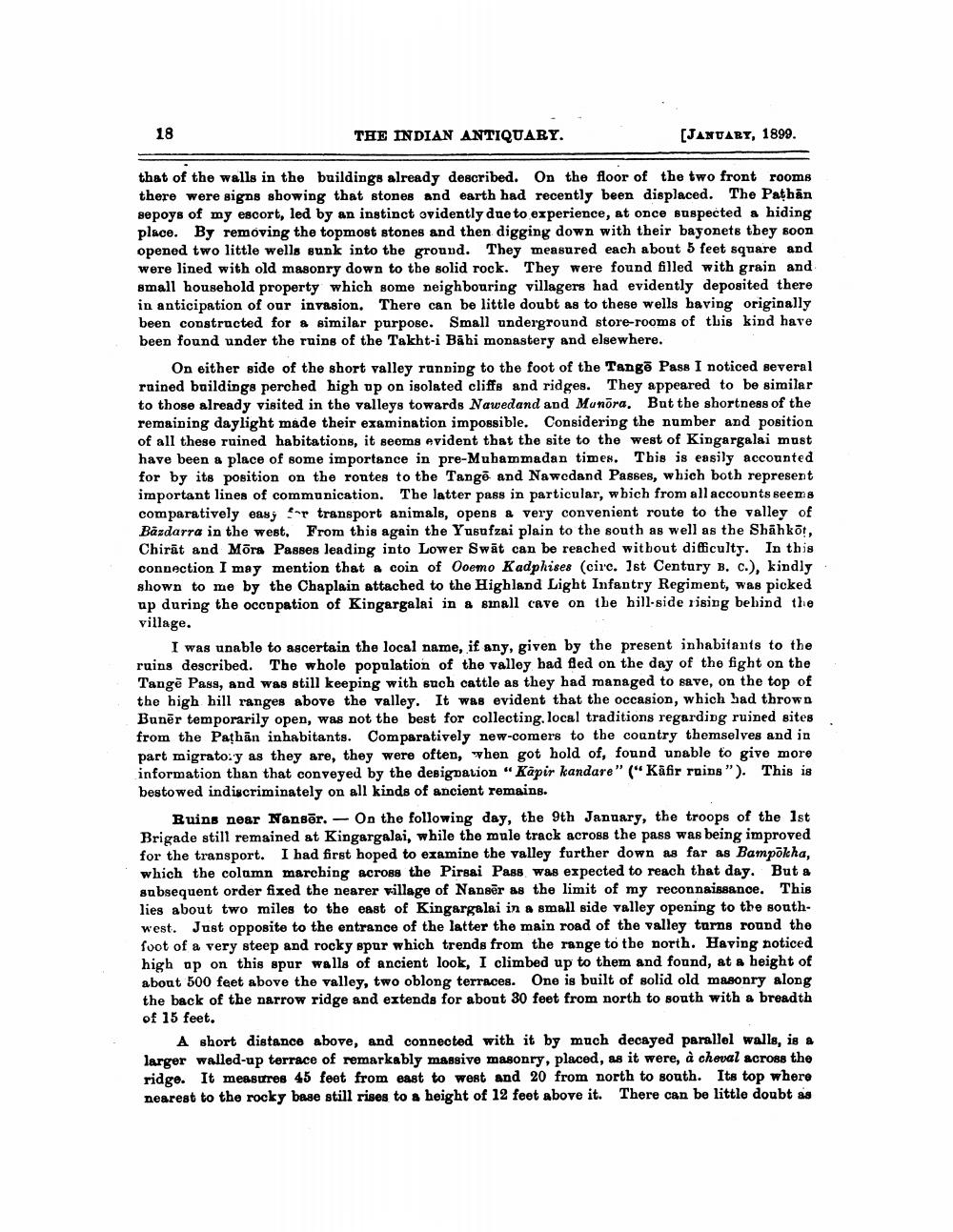________________
18
THE INDIAN ANTIQUARY.
[JANUARY, 1899.
that of the walls in the buildings already described. On the floor of the two front rooms there were signs showing that stones and earth had recently been displaced. The Pathän sepoys of my escort, led by an instinct evidently due to experience, at once suspected a hiding place. By removing the topmost stones and then digging down with their bayonets they soon opened two little wells sunk into the ground. They measured each about 5 feet square and were lined with old masonry down to the solid rock. They were found filled with grain and small household property which some neighbouring villagers had evidently deposited there in anticipation of our invasion. There can be little doubt as to these wells having originally been constructed for a similar purpose. Small underground store-rooms of this kind have been found under the ruins of the Takht-i Bahi monastery and elsewhere.
On either side of the short valley running to the foot of the Tango Pass I noticed several ruined buildings perched high up on isolated cliffs and ridges. They appeared to be similar to those already visited in the valleys towards Nawedand and Munõra. But the shortness of the remaining daylight made their examination impossible. Considering the number and position of all these ruined habitations, it seems evident that the site to the west of Kingargalai must have been a place of some importance in pre-Muhammadan times. This is easily accounted for by its position on the routes to the Tangã and Nawedand Passes, which both represent important lines of communication. The latter pass in particular, which from all accounts seems comparatively easy Sar transport animals, opens & very convenient route to the valley of Bazdarra in the west. From this again the Yusufzai plain to the south as well as the Shāhkot, Chirāt and Mõra Passes leading into Lower Swāt can be reached without difficulty. In this connection I may mention that a coin of Ooemo Kadphises (cire. 1st Century B. c.), kindly shown to me by the Chaplain attached to the Highland Light Infantry Regiment, was picked up during the occnpation of Kingargalai in a small cave on the hill-side rising behind the village.
I was unable to ascertain the local name, if any, given by the present inhabitants to the ruins described. The whole population of the valley had fled on the day of the fight on the Tange Pass, and was still keeping with such cattle as they had managed to save, on the top of the high hill ranges above the valley. It was evident that the occasion, which had thrown Bunēr temporarily open, was not the best for collecting, local traditions regarding ruined sites from the Pathän inhabitants. Comparatively new-comers to the country themselves and in part migrato:y as they are, they were often, when got hold of, found unable to give more information than that conveyed by the designation “Kapir kandare" ("Kafir ruins"). This is bestowed indiscriminately on all kinds of ancient remains.
Ruins near Nansör. - On the following day, the 9th January, the troops of the 1st Brigade still remained at Kingargalai, while the mule track across the pass was being improved for the transport. I had first hoped to examine the valley further down as far as Bampokha, which the column marching across the Pirsai Pass was expected to reach that day. But a subsequent order fixed the nearer village of Nansēr as the limit of my reconnaissance. This lies about two miles to the east of Kingargalai in a small side valley opening to the southwest. Just opposite to the entrance of the latter the main road of the valley turns round the foot of a very steep and rocky spur which trends from the range to the north. Having noticed high up on this spur walls of ancient look, I climbed up to them and found, at a height of about 500 feet above the valley, two oblong terraces. One is built of solid old masonry along the back of the narrow ridge and extends for about 30 feet from north to south with a breadth of 15 feet.
A short distance above, and connected with it by much decayed parallel walls, is a larger walled-up terrace of remarkably massive masonry, placed, as it were, à cheval across the ridge. It measures 45 feet from east to went and 20 from north to south. Its top where nearest to the rocky base still rises to a height of 12 feet above it. There can be little doubt as




